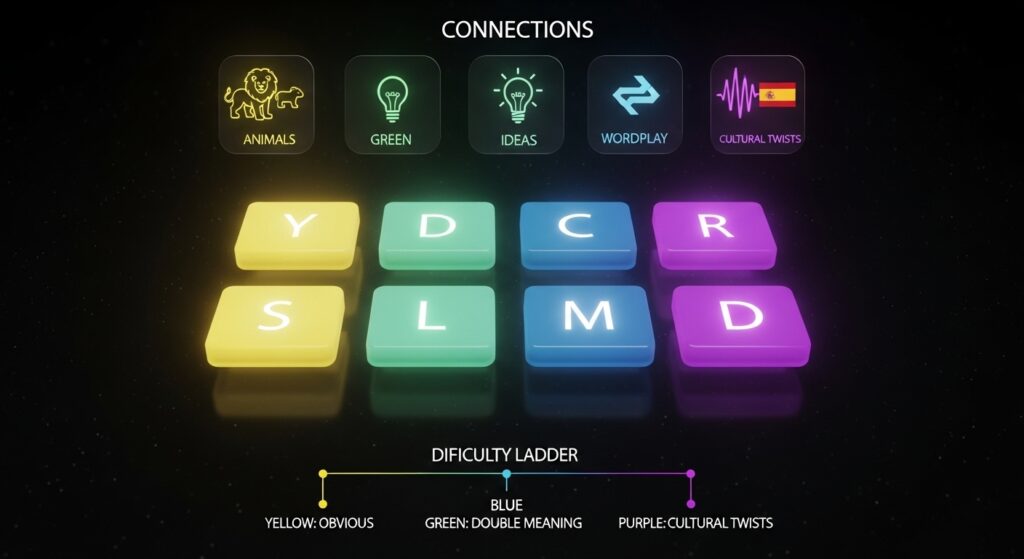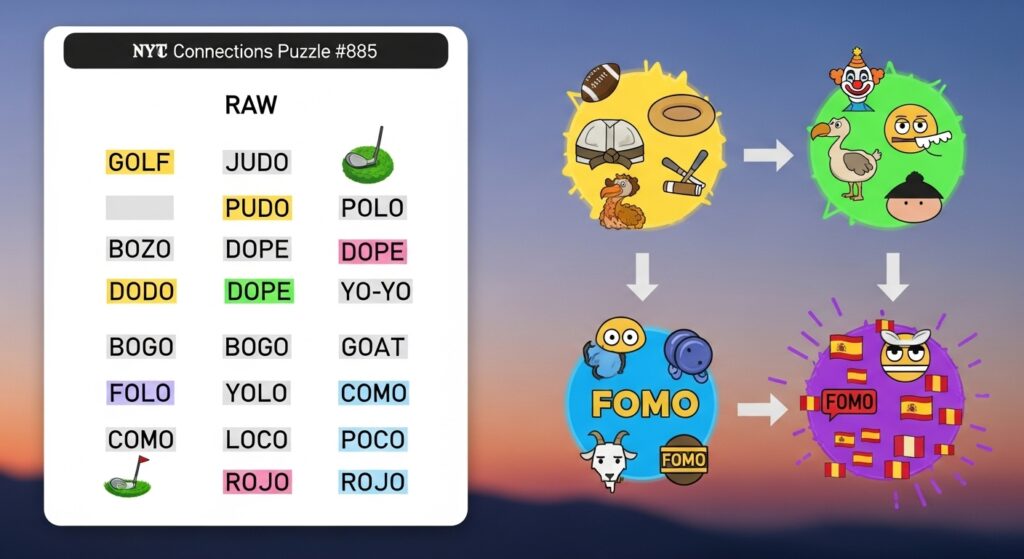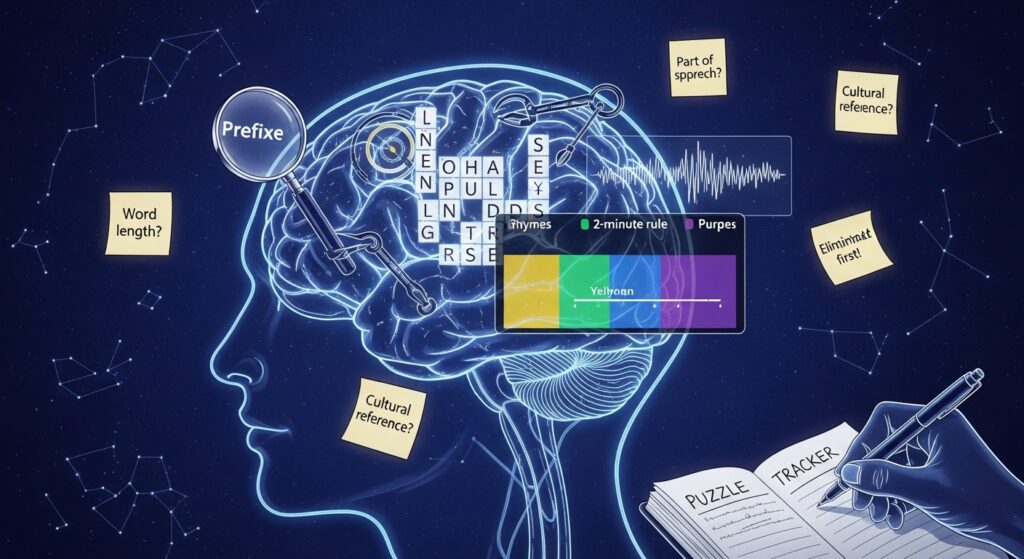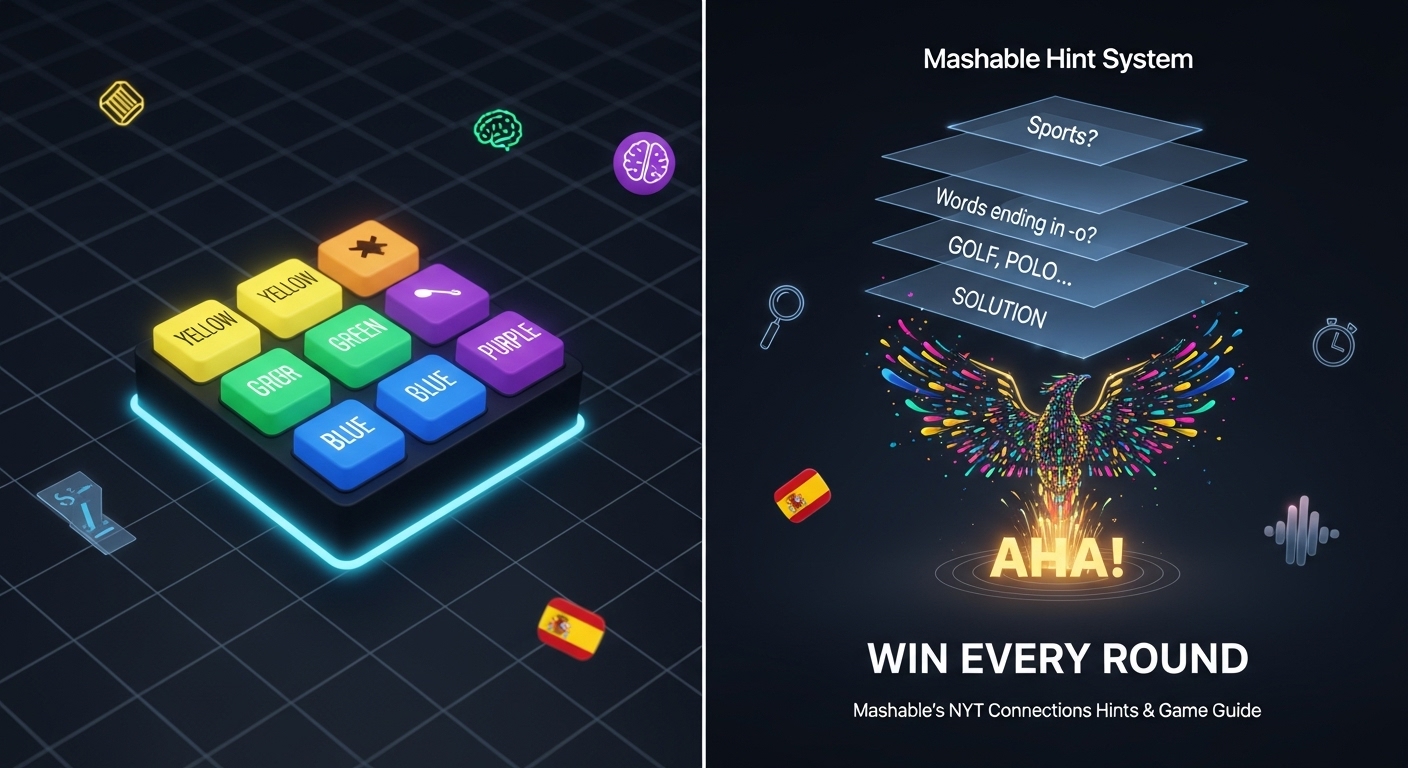Why Everyone’s Talking About Mashable’s NYT Connections Hints
If you’ve ever been stuck staring at the 16-word grid in NYT Connections wondering how on earth those four words link together—welcome. You’re not alone. This daily puzzle has taken the word-game community by storm since its release, and the hint system offered by Mashable has become one of the best ways to gain strategic help without losing all the fun.
In this guide, we’re going to dive deep into Mashable’s hint system, show you how to use it to improve your solving skills, and give you unique insights and real examples to help you win every round. We’ll explore game mechanics, hint strategy, advanced solving techniques, and even community dynamics—all aimed at giving you an edge while playing NYT Connections.
What Is NYT Connections and Why It’s Addictive
Released by The New York Times Games on June 12, 2023, NYT Connections quickly established itself as a daily favourite.
Here’s a breakdown of how it works and why it hooks you:
How it works
- Each day you’re presented with a 4×4 grid comprising 16 words.
- Your goal: Sort those 16 words into 4 categories, each containing exactly 4 words, based on what those words have in common.
- Each category is colour-coded by difficulty: Yellow (easiest), Green (medium), Blue (challenging), Purple (most difficult).
- You get up to four incorrect attempts—if you exceed that, you’ve lost your chance for that day.
Why it’s so engaging
- Pattern recognition meets wordplay: Unlike a linear “guess the word” format, this game asks you to think laterally—spot relationships, shared prefixes/suffixes, phonetics, and cultural references.
- Balanced challenge: With four distinct difficulty tiers per puzzle, you’re never safe but you also never feel completely lost.
- Daily ritual: It resets every day (midnight local time), so there’s a consistent itch to solve it.
- Community buzz: Because the puzzles can be tricky, players share insights, strategies, and sometimes frustrations across forums and social media.
By understanding the game structure deeply, you’re already ahead. Next, we’ll look at how the colour system and difficulty tiers work in detail.
Understanding the Colour System and Difficulty Levels
To play smarter, you need to know what each colour hints at. Each tier signals not just greater difficulty but a type of connection you’ll encounter more often.
| Colour | Difficulty | Typical Connection Type |
|---|---|---|
| Yellow | Easiest | Obvious categories (e.g., animals, foods) |
| Green | Medium | Related concepts, fields or broader categories |
| Blue | Challenging | Word relationships, usage patterns, double meanings |
| Purple | Most Difficult | Obscure, punny connections, cultural/phonetic twist |
This classification aligns with data showing how many players get “purple” groups wrong more often than yellow or green.

What you should do with this knowledge
- Start with Yellow when you feel stuck—it’s often the fastest win.
- Use Yellow success to free up cognitive load and then tackle Green and Blue while fresh.
- When you reach Purple, expect trickiness: think phonetic patterns, cultural references, homophones, or words used in an unusual sense.
- If you’re aiming for speed, track your success across colours—how many attempts you used for each tier.
With the game understood, let’s look at how Mashable’s hint system gives you a strategic edge.
The Mashable Difference: A Smarter Hint System
While official hints from the Times exist, they’re limited. Mashable raises the bar with a tiered, player-centric system that gives you just enough help to progress without spoiling the fun.
What makes Mashable’s system special
- Tiered progression:
- Category hints (vague descriptions)
- Word pattern hints (more specific)
- Partial answers (one or two words revealed)
- Full solutions (last resort)
This structure lets you choose how much help you need.
- Visual & UI enhancements: Colour-coded sections to match the puzzle, collapsible spoilers, “hint maps” to illustrate overlaps.
- Consistency and reliability: New hints typically appear within hours of the puzzle release, building trust among puzzlers.
- Community feedback loop: Mashable’s comment sections allow reader suggestions, improving hint quality over time.
Why that matters
Imagine you’re stuck on a Blue or Purple group. With the conventional hint you might get one clue and still be lost. With Mashable, you can start with just enough—a nod toward the solution—then escalate only if you remain stuck. This helps you build your pattern-recognition muscle, not just lean on the hint.
Next, we’ll peel back the curtain on how Mashable actually builds these hints.
Behind the Scenes: How Mashable Creates Their Hints
Understanding how the hints are constructed gives you insight into what you should pay attention to as a player.
Internal hint-creation workflow
- Editors at Mashable (often former puzzle-solvers themselves) play the puzzle independently, tracking their solving process to identify the “trip points” where players usually fail.
- They analyze relationships based on linguistic cues (prefixes/suffixes), semantic fields (themes, categories), phonetic patterns (rhymes, homophones), and cultural references.
- Hints are then crafted so that each level reveals just a bit more of the underlying logic without giving the answer away too early.
Accuracy & community corrections
Mashable maintains an accuracy rate above 99% for their hint articles. While rare errors do occur, the corrections policy is rigorous and transparent. (Their own blog/outlet cites this rate.)
Because of this, you can trust the article as authoritative—but still treat it as a tool, not a crutch.
This leads us into the heart of gameplay: recognizing the kinds of connections that pop up repeatedly and how Mashable structures hints around them.
Decoding the Puzzle: Common Connection Types Explained
To stay ahead of the curve, you’ll want to recognize common patterns that appear again and again in NYT Connections puzzles. Mashable’s hints are designed to target these patterns.

Recurring connection types
- Homophones / Rhymes: Words that sound alike but differ in spelling or meaning (e.g., “flies,” “ties,” “lies,” “pies” from a Purple group example).
- Thematic sets: Items that clearly belong to a larger category (animals, foods, countries).
- Prefix/suffix or word-form families: All verbs or all nouns sharing a suffix (e.g., “cast,” “mold,” “stamp,” “edition” — where the connection wasn’t obvious until you realized they’re all manufacturing-verbs).
- Cultural references: Movie titles, song lyrics, historical quotes, idiomatic expressions.
- Usage pattern or grammar trick: Words that function similarly (e.g., all can be preceded by “snow,” or all contain double letters).
- Red herrings / overlaps: Words that seem to fit multiple groups until you dig deeper.
Example from a real puzzle
In Puzzle #885 (November 12, 2025) the groups were: Yellow – SPORTS; Green – DOOFUS; Blue – ACRONYMS; Purple – SPANISH WORDS.
- Yellow: GOLF, JUDO, POLO, SUMO
- Green: BOZO, DODO, DOPE, YO-YO
- Blue: BOGO, FOMO, GOAT, YOLO
- Purple: COMO, LOCO, POCO, ROJO
Notice how the Blue group is modern slang/acronyms, whereas the Purple draws on Spanish vocabulary. Recognising those meta-patterns before looking at the words speeds you up significantly.
What you should practice
- When you glance at the grid: look for obvious clusters (sports, foods, colours) to lock down Yellow quickly.
- Then inspect remaining words for less obvious patterns: shared letters, word-class (verbs/nouns), phonetic patterns.
- For the hardest group (Purple): anticipate non-obvious links—sound-based, foreign-language, homograph/homophone, punny.
With those patterns familiar, you’ll make faster use of Mashable’s hints and avoid wasting attempts. Let’s look at a unique feature they provide: the hint map.
Mashable’s “Hint Map” Visualization: A Hidden Gem
One of Mashable’s subtle advantages: they often include a visual hint map to illustrate relationships and overlaps between categories. This may be an annotated diagram, a colour-coded grid, or an interactive component.

Why this matters
- It externalises your thinking—so you don’t just stare at words, you map them visually.
- It helps with category overlap avoidance: you’ll see where words might fit in two categories and can reassess accordingly.
- For players with a more visual learning style, it reinforces memory of connection-types (making future puzzles faster).
How to use it effectively
- Before you look for broad themes, recreate a small scratch-map on paper: mark the four words you think belong together and draw a line; map potential overlaps.
- Use Mashable’s hint map to validate or refine your draft map.
- Over time, your mental pattern-library will expand: the more you engage visually, the faster you’ll spot Purple tier trickiness.
With these foundational tools in place, let’s step into advanced solving strategies used by top players.
Advanced Solving Strategies from Puzzle Masters
Casual players may solve a Yellow and call it a day. Masters elevate the game by thinking proactively, strategically, and visually.

Pattern recognition tactics
- Word length and structure: Are all four words the same number of letters? That’s a quick check.
- Part of speech–matching: Are all four verbs? All nouns? All adjectives?
- Prefix/suffix clustering: Do they share beginnings or endings (e.g., “–ing,” “pre–,” “post–”)?
- First/last letter patterns: Do they all end with the same letter or begin with the same sound?
Elimination method
- Identify the easiest group (usually Yellow) and solve it first—removes four words and simplifies the remaining grid.
- Remove those four words physically or mentally—then focus on remaining three groups.
- Repeat elimination until you zero in on tricky connections.
Word-association techniques
- Create a sentence using each candidate word in the same position—this often reveals semantic connection or misfit.
- Think cultural context: for example, if words are “FOMO,” “YOLO,” “GOAT,” “BOGO”—slang and acronyms pop out.
- Try substitution: replace each word in one of your tentative groups with a wildcard (“____”) and see if the pattern still holds.
Timing and mental heuristics
- One popular approach: “two-minute rule” — if you’re stuck for over two minutes without progress, switch your approach (from thematic scanning to phonetic/structural scanning).
- Category-scan first 30 seconds: Glance through all 16 words and try to spot one obvious quartet, don’t dive deeply yet.
Memory-building and reinforcement
- Keep a puzzle journal tracking your mistakes and successes. Many masters note down: “Purple group stumbled on phonetic rhyme” or “Green group theme was obscure idiom.”
- Build personal category lists from past puzzles to review: e.g., “words that end in –o,” “verbs used as nouns,” “foods that are also colours.”
- One regular streak player said: “I track every category I miss in a spreadsheet. After three months, I rarely miss the same type twice.”
By adopting these strategies, you’ll move from reacting to hints to anticipating them—and solving faster and more confidently.
When to Use Hints (and When Not To)
Hints are powerful—but they’re more effective when used strategically, not reflexively. Here’s how to decide.
Progressive hint-strategy (via Mashable)
- Attempt the puzzle fully on your own first.
- If you’re stuck after two incorrect guesses, check only the category hints.
- Make another attempt; if still stuck, check word pattern hints.
- Use partial answers only if you’re firmly stuck.
- Use complete solutions only as a last resort (and ideally review what you missed afterward).
Recognising mental roadblocks
- Fixation block: When you keep returning to a wrong pattern and can’t see beyond it. Hint: change categories or step away for a moment.
- Vocabulary block: When you’re unfamiliar with one of the words. Hint: look up the word meaning before guessing.
- Conceptual block: When the category itself is unfamiliar. Hint: use the category hint level to broaden perspective.
Learning-focused hint use
- Remember: The real goal isn’t just solving today’s puzzle—it’s building your solving intuition.
- After using hints, pause and ask: “Which word/connection did I miss? Why?”
- Consider avoiding hints entirely on some days (e.g., “Monday method”) to build raw skill rather than dependency.
The Community Factor: Learning Together
Playing in isolation is fine—but the real boost often comes from community engagement. Mashable, Reddit, Twitter—they’re all part of the ecosystem.
Where the community lives
- Mashable’s comment sections under hint articles: players share alternate groupings, explanations, and suggest patterns.
- Reddit — especially sub-r/NYTConnections: crowdsourced solutions, debates, insight into trickiest puzzles.
- Twitter — hashtag #NYTConnections: quick reactions, snapshot comments, insight from solvers worldwide.
How community interaction helps
- You’ll discover alternate solutions—sometimes there are multiple valid ways to categorize if you think of a word differently.
- You’ll learn new patterns faster when others explain their thought process (“oh, I saw the prefix ‘pre–’ and realized …”).
- You’ll stay motivated—seeing “aha moments” from other solvers reinforces your own progress.
How to engage smartly
- Read but don’t just copy: when someone posts a strategy, ask why it worked.
- Contribute your own insights: “I noticed both A and B ended in –ing, so I grouped them …”
- Use community suggestions as a booster—but make sure you internalise the logic rather than just memorising the grouping.
Comparative Insight: Mashable vs. Other Hint Platforms
Not all hint providers are created equal. Here’s a quick comparison:
| Source | Hint Style | Speed | Depth / Engagement |
|---|---|---|---|
| The New York Times Official | Single-level hint | Same day | Minimal |
| Reddit (r/NYTConnections) | Crowdsourced threads & comments | Varies | High risk of spoilers |
| Twitter hint accounts | Concise tweets, fast | Very fast | Shallow detail |
| Independent sites | Varies (forums, blogs) | Medium | Varies engagement |
| Mashable | Tiered progressive hints + visuals | Fast (hours) | Balanced – depth + community |
Why Mashable often leads
- Timely release of hints, often within hours of the puzzle dropping.
- ∙Tiered structure that gives you flexibility and control.
- Visual aids and “hint map” mentality to support different learning styles.
- Active comment section and community integration.
Because of this, many serious solvers consider Mashable’s hint system a “go-to” to refine their skills rather than just “get the answer.”
Expert Tips to Boost Your Connections Game
If you’re ready to move from good to great, here are the refined techniques top solvers consistently use:
- Category memory mapping: Keep personal lists of past category-types (e.g., “sports ending in –o,” “verbs + double letters,” “Spanish words you hear in pop songs”).
- Sentence construction trick: For each word in a suspect quartet, create a sentence. If one feels forced, reconsider the grouping.
- Use a “mini-grid” test: Before selecting four words, mentally form three possible groups from remaining words and check overlaps.
- Tracking time per colour tier: e.g., note: “Today I solved Yellow in 45 s, Green in 90 s, Blue in 2 m30 s; Purple still >3 minutes.” Over time you’ll see improvement.
- Visual mapping in notes: Use colour highlighters in printouts of past puzzles, mark recurring patterns.
- Practice “create your own” puzzles: Try inventing a 4×4 grid with word groups, then let a friend solve—this builds your recognition of what makes connections “tick”.
Troubleshooting Common Connections Challenges
Even with these tools, certain tricky situations pop up frequently. Here’s how to deal with them.
Split-groups and red herrings
- Some puzzles may include words that could fit two groups—this is intentional misdirection.
- Strategy: When in doubt, don’t commit immediately. Look at remaining words, see whether you can avoid overlap.
- Example: Words about weather might be split across two categories (e.g., one group on “storms,” another on “precipitation types”).
Managing limited attempts
- With only four mistakes allowed, verify your group before selecting.
- Always ensure your group has exactly four words and that each word truly fits the theme—not just loosely.
- On your last allowed attempt, use elimination: choose the grouping that’s left and make sure none of its words already fit another confirmed group.
Ambiguous word meanings
- Words with multiple senses (homographs) are common in Purple groups. Example: “BASS” (fish vs. sound) or “LEAD” (metal vs. to guide).
- If you suspect ambiguity, consider alternate meanings—Mashable’s hints often point to the less obvious sense.
When to restart vs use hints
| Situation | Recommended Action |
|---|---|
| First attempt failure | Continue without hints |
| Second attempt failure | Check category hints |
| Third attempt failure | Use word-pattern hints |
| Final attempt approaching | Consider partial answers or full hints |
Special challenge: ambiguous words
Sometimes puzzles include words that deliberately span multiple possible themes—these are mental traps. Mashable often releases a “disambiguation hint” for such cases. Pay attention to that if you see it.
How to Track Your Progress Like a Pro
Turning daily play into consistent improvement means tracking and measuring. Here’s how:
What to record
- Date & puzzle number
- Time taken for each colour tier
- Number of attempts used
- Hint level used (none, category, pattern, partial, full)
- What you missed and why (e.g., “missed suffix –ing pattern” or “overlooked Spanish word”).

Why tracking helps
- You’ll see which tier you consistently struggle with (e.g., Purple category).
- You can identify which pattern types you miss most often (idioms, cultural references, word-forms).
- Over time you’ll build a personalised database of your weak spots and work to improve them.
Example tracker format
| Date | Puzzle # | Yellow time | Green time | Blue time | Purple time | Attempts used | Hint level | Notes |
|---|---|---|---|---|---|---|---|---|
| 2025-11-12 | #885 | 0:45 | 1:15 | 2:40 | 3:10 | 2 | Category | Purple group Spanish words |
The Future of NYT Connections and Hint Systems
Gaming and puzzle design evolve, and so does the hint ecosystem. Here’s what to watch.
Emerging trends
- With the rise of AI and puzzle generation research, games like NYT Connections are becoming benchmarks for reasoning. One academic paper found even top language models trail human solvers by ~30%.
- As puzzles adopt deeper word-play and cultural sophistication, hint systems will need to become more dynamic—possibly interactive hints, adaptive hint difficulty based on player history, or time-based coaching modes.
- Mashable and other providers might evolve toward gamified coaching: tracking your skill zones, recommending drills based on your mistakes, integrating video or interactive hint-maps.
What this means for you
To stay ahead:
- Continue training your pattern library rather than relying solely on hints.
- Embrace new hint formats (visual mapping, interactive drills) as they emerge.
- Treat every puzzle as both game and training session—you’re building cognitive agility, not just solving for the day.
Conclusion: Turning Hints Into Habits
By now you should have a well-rounded understanding of how to approach NYT Connections intelligently, how to use Mashable’s hint system strategically, and how to build long-term improvement rather than just short-term wins.
Here’s your takeaway:
- The target keyword here—Mashable’s NYT Connections hints—is more than just a hint-provider—it’s a training tool.
- Use hints not just to win today, but to refine your thinking for tomorrow’s puzzle.
- Engage with the community, track your progress, recognise your patterns, and play with intention.
When you do all that, you’ll find that the best hint isn’t the one that gives you the answer—it’s the one that triggers your own “aha!” moment. And that’s exactly the kind of solving where you win every round.



